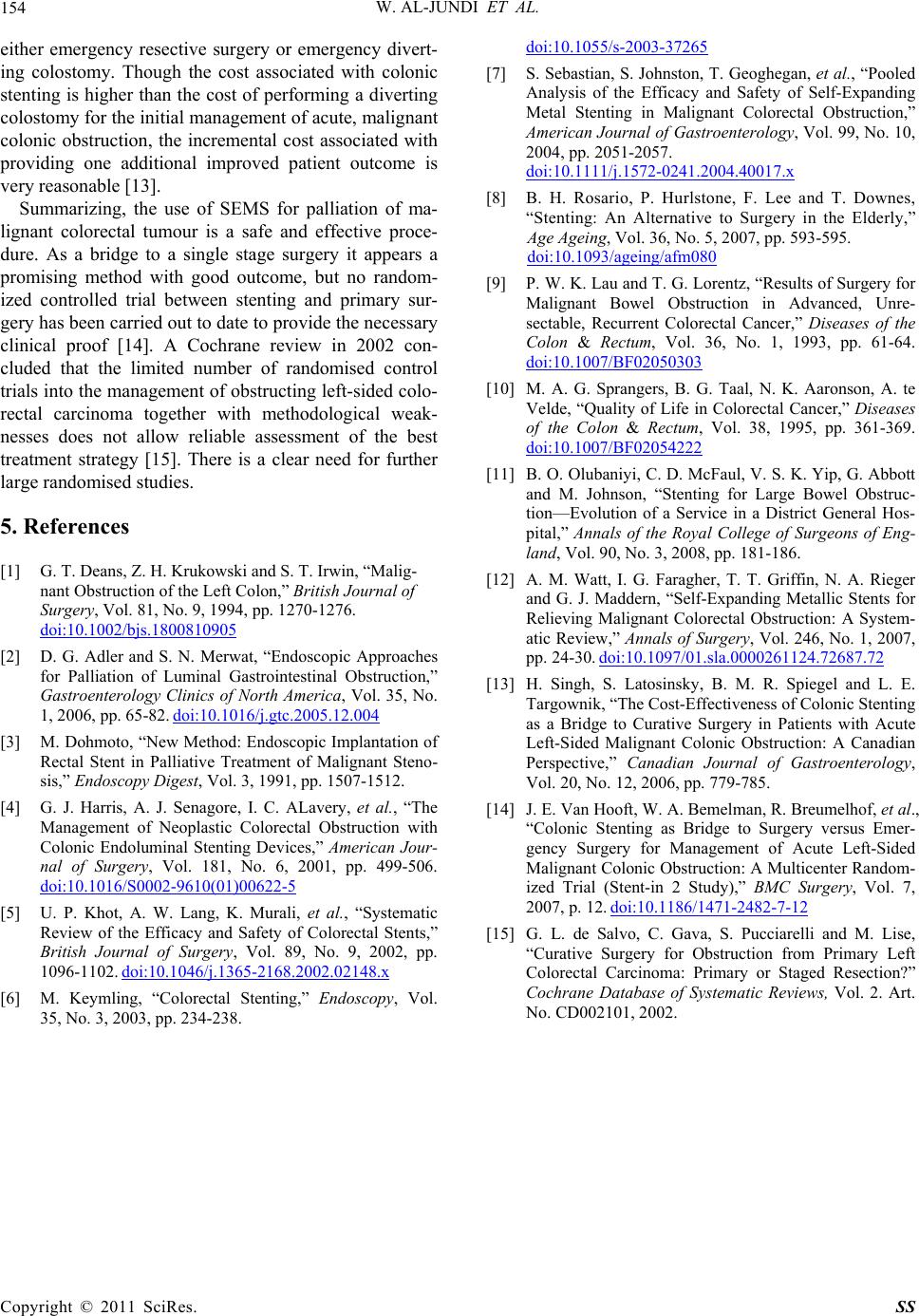
W. AL-JUNDI ET AL.
Copyright © 2011 SciRes. SS
154
either emergency resective surgery or emergency divert-
ing colostomy. Though the cost associated with colonic
stenting is higher than the cost of performing a diverting
colostomy for the initial management of acute, malignant
colonic obstruction, the incremental cost associated with
providing one additional improved patient outcome is
very reasonable [13].
Summarizing, the use of SEMS for palliation of ma-
lignant colorectal tumour is a safe and effective proce-
dure. As a bridge to a single stage surgery it appears a
promising method with good outcome, but no random-
ized controlled trial between stenting and primary sur-
gery has been carried out to date to provide the necessary
clinical proof [14]. A Cochrane review in 2002 con-
cluded that the limited number of randomised control
trials into the management of obstructing left-sid ed colo-
rectal carcinoma together with methodological weak-
nesses does not allow reliable assessment of the best
treatment strategy [15]. There is a clear need for further
large randomised studies.
5. References
[1] G. T. Deans, Z. H. Krukowski and S. T. Irwin, “Malig-
nant Obstruction of the Left Colon,” British Journal of
Surgery, Vol. 81, No. 9, 1994, pp. 1270-1276.
doi:10.1002/bjs.1800810905
[2] D. G. Adler and S. N. Merwat, “Endoscopic Approaches
for Palliation of Luminal Gastrointestinal Obstruction,”
Gastroenterology Clinics of North America, Vol. 35, No.
1, 2006, pp. 65-82. doi:10.1016/j.gtc.2005.12.004
[3] M. Dohmoto, “New Method: Endoscopic Implantation of
Rectal Stent in Palliative Treatment of Malignant Steno-
sis,” Endoscopy Digest, Vol. 3, 1991, pp. 1507-1512.
[4] G. J. Harris, A. J. Senagore, I. C. ALavery, et al., “The
Management of Neoplastic Colorectal Obstruction with
Colonic Endoluminal Stenting Devices,” American Jour-
nal of Surgery, Vol. 181, No. 6, 2001, pp. 499-506.
doi:10.1016/S0002-9610(01)00622-5
[5] U. P. Khot, A. W. Lang, K. Murali, et al., “Systematic
Review of the Efficacy and Safety of Colorectal Stents,”
British Journal of Surgery, Vol. 89, No. 9, 2002, pp.
1096-1102. doi:10.1046/j.1365-2168.2002.02148.x
[6] M. Keymling, “Colorectal Stenting,” Endoscopy, Vol.
35, No. 3, 2003, pp. 234-238.
doi:10.1055/s-2003-37265
[7] S. Sebastian, S. Johnston, T. Geoghegan, et al., “Pooled
Analysis of the Efficacy and Safety of Self-Expanding
Metal Stenting in Malignant Colorectal Obstruction,”
American Journal of Gastroenterology, Vol. 99, No. 10,
2004, pp. 2051-2057.
doi:10.1111/j.1572-0241.2004.40017.x
[8] B. H. Rosario, P. Hurlstone, F. Lee and T. Downes,
“Stenting: An Alternative to Surgery in the Elderly,”
Age Ageing, Vol. 36, No. 5, 2007, pp. 593-595.
doi:10.1093/ageing/afm080
[9] P. W. K. Lau and T. G. Lorentz, “Results of Surgery for
Malignant Bowel Obstruction in Advanced, Unre-
sectable, Recurrent Colorectal Cancer,” Diseases of the
Colon & Rectum, Vol. 36, No. 1, 1993, pp. 61-64.
doi:10.1007/BF02050303
[10] M. A. G. Sprangers, B. G. Taal, N. K. Aaronson, A. te
Velde, “Quality of Life in Colorectal Cancer,” Diseases
of the Colon & Rectum, Vol. 38, 1995, pp. 361-369.
doi:10.1007/BF02054222
[11] B. O. Olubaniyi, C. D. McFaul, V. S. K. Yip, G. Abbott
and M. Johnson, “Stenting for Large Bowel Obstruc-
tion—Evolution of a Service in a District General Hos-
pital,” Annals of the Royal College of Surgeons of Eng-
land, Vol. 90, No. 3, 2008, pp. 181-186.
[12] A. M. Watt, I. G. Faragher, T. T. Griffin, N. A. Rieger
and G. J. Maddern, “Self-Expanding Metallic Stents for
Relieving Malignant Colorectal Obstruction: A System-
atic Review,” Annals of Surgery, Vol. 246, No. 1, 2007,
pp. 24-30. doi:10.1097/01.sla.0000261124.72687.72
[13] H. Singh, S. Latosinsky, B. M. R. Spiegel and L. E.
Targownik, “The Cost-Effectiveness of Colonic Stenting
as a Bridge to Curative Surgery in Patients with Acute
Left-Sided Malignant Colonic Obstruction: A Canadian
Perspective,” Canadian Journal of Gastroenterology,
Vol. 20, No. 12, 2006, pp. 779-785.
[14] J. E. Van Hooft, W. A. Bemelman, R. Breumelhof, et al.,
“Colonic Stenting as Bridge to Surgery versus Emer-
gency Surgery for Management of Acute Left-Sided
Malignant Colonic Obstruction: A Multicenter Random-
ized Trial (Stent-in 2 Study),” BMC Surgery, Vol. 7,
2007, p. 12. doi:10.1186/1471-2482-7-12
[15] G. L. de Salvo, C. Gava, S. Pucciarelli and M. Lise,
“Curative Surgery for Obstruction from Primary Left
Colorectal Carcinoma: Primary or Staged Resection?”
Cochrane Database of Systematic Reviews, Vol. 2. Art.
No. CD002101, 2002.